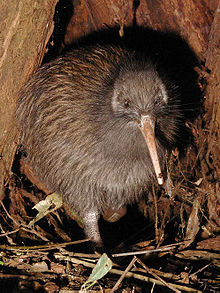Brown kiwi
| Kiwi | |
|---|---|
 |
|
|
North Island brown kiwi (Apteryx mantelli) |
|
| Scientific classification | |
| Kingdom: | Animalia |
| Phylum: | Chordata |
| Class: | Aves |
| Clade: | Novaeratitae |
| Order: |
Apterygiformes Haeckel, 1866 |
| Family: |
Apterygidae Gray, 1840 |
| Genus: |
Apteryx Shaw, 1813 |
| Type species | |
|
Apteryx australis Shaw & Nodder, 1813 |
|
| Species | |
|
Apteryx haastii Great spotted kiwi |
|
 |
|
| The distribution of each species of kiwi | |
| Synonyms | |
|
Stictapteryx Iredale & Mathews, 1926 |
|
Apteryx haastii Great spotted kiwi
Apteryx owenii Little spotted kiwi
Apteryx rowi Okarito brown kiwi
Apteryx australis Southern brown kiwi
Apteryx mantelli North Island brown kiwi
Stictapteryx Iredale & Mathews, 1926
Kiwi Verheyen, 1960
Pseudapteryx Lydekker 1891
Kiwi (pronounced /kiːwiː/) or kiwis are flightless birds native to New Zealand, in the genus Apteryx and family Apterygidae. At around the size of a domestic chicken, kiwi are by far the smallest living ratites (which also consist of ostriches, emus, rheas, and cassowaries), and lay the largest egg in relation to their body size of any species of bird in the world.
DNA sequence comparisons have yielded the surprising conclusion that kiwi are much more closely related to the extinct Malagasy elephant birds than to the moa with which they shared New Zealand. There are five recognised species, two of which are currently vulnerable, one of which is endangered, and one of which is critically endangered. All species have been negatively affected by historic deforestation but currently the remaining large areas of their forest habitat are well protected in reserves and national parks. At present, the greatest threat to their survival is predation by invasive mammalian predators.
...
Wikipedia
